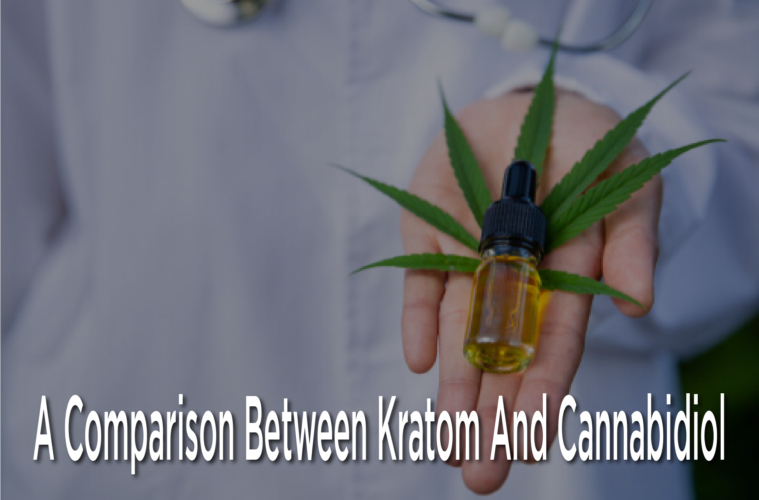This article was originally published on The Right CBD Products. To view the original article, please click here.
Kratom and cannabidiol have been gaining popularity, so it is natural for one to think of comparing the potential benefits and effects of the two. Hemp CBD has been much talked about in the world of naturopathy for a while now. It is a well-known alternative medicine for several health conditions.
Still, there are plants other than hemp rising to prominence owing to their therapeutic effects, and kratom is one of these herbs. Here, we will explore how kratom compares to cannabidiol. Is it an effective alternative for cannabidiol, as some individuals claim? There seem to be many things common among cannabidiol and kratom, but digging a little deeper makes it clear that these are pretty different.
The Basics Of Cannabidiol
Hemp CBD is present in an array of goods that include gummies, oils, food items, and drinks, plus topical products. It is a non-habit-forming and non-psychotropic substance having many different health benefits. The major purpose of the industrial hemp-derived substance is creating an internal bodily balance, by interacting with the ECS (endocannabinoid system).
Cannabidiol is popular among consumers partly because it has no mind-altering effect, like the more popular cannabis compound namely tetrahydrocannabinol. Cannabidiol can help to make you feel better, manage anxiety, and cope with pain, with none of the psychoactive effects of THC.
It shows promise in treating more severe health issues, like cancer to name one. As further research is being conducted, more and more conventional medical professionals are acting as advocates of CBD.
Overview Of Kratom
More commonly referred to as kratom, Mitragyna speciosa is a plant, native to South East Asia. Kratom grows in places such as Malaysia, Papua New Guinea, Indonesia, and Thailand. Inhabitants of the aforesaid places have consumed it for years. Conventionally, they have chewed kratom leaves for the effects of it that are similar to those of ‘stimulant’ drugs.
Mitragyna speciosa has a history of consumption as an alternative to opium, and it has turned trendy as a substance in the form of recreational medication.
7-Hydroxymitragynine and mitragenie are the two major active compounds of kratom. The aforesaid components of the herb interact with opioid receptors in the body, and thereby, have their effects. Mitragenie is considered the causative factor in the therapeutic properties, and scientists attribute the psychotropic effects to 7-Hydroxymitragynine. There is not much scientific research into kratom even today, which keeps it from becoming as popular as cannabidiol.
Kratom Versus Cannabidiol: Applications
It is possible to consume cannabidiol for numerous purposes. This explains why the CBD benefits list is a pretty long one. The hemp derivative is most often consumed to manage sleep issues, anxiety, inflammation, and long-term pain.
Several individuals consume CBD for better relaxation and managing stress-associated symptoms, but the product is turning trendy among fitness-fanatics. Athletes, especially, take it to better deal with pain and better recover from minor injuries that happen when exercising. Besides these practical applications, cannabidiol is studied for the therapeutic possibility of it for more serious health conditions like cancer, multiple sclerosis, diabetes, epilepsy, Parkinson’s disease, and heart disease.
Cannabidiol is non-habit-forming, and it seems safe even when you consume pretty large dosages. Conversely, kratom is potentially addictive and has many potential side effects.
This herb is consumed largely to ease pain, alleviate anxiety, and manage opiate dependence. Research around kratom appears to be at the initial phases even now, so it is not possible to draw any solid conclusion. Judging by anecdotes, including the accounts of early herb consumers, the claimed benefits of it might just be somewhat true. Some claim that it is very effective in stopping reliance on opioids such as oxycodone and heroin. Still, further clinical research has to be done for it to be possibly considered a reliable treatment option.
Kratom Versus Cannabidiol: Side Effects
Cannabidiol has minimal side effects only. There is evidence that cannabidiol is not addictive, and that it is safe to take even at high dosages. There has not been any documented case of demise associated with cannabidiol. Its users might just experience minor side effects such as dry mouth, nausea, and tiredness.
Look deeper into its side effects, and kratom will seem a less attractive option for your health and wellbeing. Some claim that kratom could help to solve opiate dependence, but it is possible for the user to be addicted to it. Medical professionals never recommend using it frequently, because this makes addiction more likely.
Some rather common side effects of it are constipation, nausea, and vomiting. The undesirable kratom effects list does not end there because more serious symptoms might result from its consumption like seizures, liver toxicity, depression, and increased hypertension. The aforementioned effects of kratom are greater than their benefits.
Advertising disclosure: We may receive compensation for some of the links in our stories. Thank you for supporting Irvine Weekly and our advertisers.


